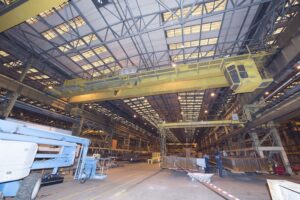J Murphy Aggregates Ltd, Shaun Murphy and James Duggan have been sentenced at Leeds Crown Court for safety breaches after a worker was struck by a falling excavator. In addition, J Murphy Aggregates Ltd was sentenced for safety breaches in a separate incident after a wagon driver sustained severe crush injuries to his right leg when he was dragged under a 360 excavator.
York Crown Court had previously heard that J Murphy Aggregates Ltd was engaged in waste management/collection of non-hazardous waste, typically tarmac, brick rubble and broken concrete, which is further broken down and then sold on as hardcore to building sites. The sole director is Shaun Murphy. Prior to the incident, the company were using agency staff on occasion to cover some tasks.
An investigation by the Health and Safety Executive (HSE) found that James Duggan had been initially employed as a crusher machine operator via an employment agency and held a Construction Plant Competence Scheme (CPCS) card to do so. However, he was then employed directly by Shaun Murphy to operate a tracked excavator, despite not holding formal qualifications for operating one. Mr Duggan was using the excavator to “munch” a stockpile when the ground below the excavator collapsed. The excavator then tumbled down the stockpile and collided with a worker who was catapulted off the crushing machine he was maintaining at the time.
The 58-year-old worker suffered multiple fractures to both legs, a dislocated kneecap, a right sided fracture to the pelvis and hip, two punctured lungs, and a right sided fracture to the skull. He also required ten stitches to the head. He remained in hospital for a year, during which time his right hip was removed. His right leg is now significantly shorter than his left leg.
J Murphy Aggregates Ltd of Viaduct Street Pudsey Leeds West Yorkshire pleaded guilty to breaching Section 2 (1) and Section 3 (1) of the Health & Safety at Work etc Act 1974. The company was fined £70,000.
Shaun Murphy, Director, of Viaduct Street, Pudsey, Leeds pleaded guilty to breaching Section 2 (1) and Section 3 (1) by virtue of section 37(1) of the Health & Safety at Work etc Act 1974. He was sentenced to an eight-month custodial sentence, suspended for two years, and 160 hours of community service. He is also required to attend 20 rehabilitation activity requirement days and pay £2,242.50 costs.
James Duggan, Excavator Operator, of Snawthorne Grove, Castleford West, Yorkshire pleaded guilty to breaching Section 7 (a) and Section 3 (2) of the Health & Safety at Work etc Act 1974. He received and eight-month custodial sentence, suspended for two years, and order to pay £2,242.50 costs.
J Murphy Aggregates Ltd was also sentenced in relation to a later incident in which a wagon driver sustained severe crush injuries to his right leg when it was dragged under a 360 excavator.
Leeds Magistrates’ Court had previously heard that, on 4 December 2020, the wagon driver’s tipper vehicle was being loaded with rubbish by a 360 Excavator. He was standing watching this being done. He then approached the side of the wagon to retrieve some overhanging rubbish, before walking between the excavator and wagon and standing towards the rear of the vehicle near to the right-hand track of the excavator. The excavator tracked forwards, dragging his right leg under it, and crushing it.
His right leg was broken and degloved below the knee. He underwent several operations to repair the open fractures and have muscle and skin grafts. A muscle graft subsequently failed in his right ankle and following other complications his right leg was amputated below the knee. His left leg has also been left badly scarred and damaged from the skin and muscle grafts taken from it.
An investigation by the Health and Safety Executive (HSE) found that there was no effective segregation between heavy vehicles and pedestrians in the yard. CCTV footage of the two weeks prior to the accident showed several occasions where plant machinery almost contacted a pedestrian. In the period immediately prior to the accident, other pedestrians are seen on foot within the danger zone of the excavator as it is loading wagons with rubbish.
J Murphy Aggregates Ltd of Viaduct Street, Stanningley, Pudsey, West Yorkshire pleaded guilty to breaching Section 2 (1) of the Health & Safety at Work etc Act 1974. For this offence, the company was fined £50,000. J Murphy Aggregates Ltd was ordered to pay a total of £8,750 costs.
After the hearing, HSE inspector David Beaton commented: “These cases are a damning indictment of a company which has consistently permitted unsafe systems of work. Shaun Murphy failed to ensure that James Duggan had the relevant skills, knowledge, experience and training to use the excavator at the site. James Duggan knew he was only qualified to operate a crusher as permitted by his CPCS card.
“The result was this tragic incident which could so easily have been avoided by using the correct control measures and safe working practices.
“That another worker should sustain injury as a result of J Murphy’s failure to implement safe systems of work is deplorable. Segregation measures should have been in place to prevent pedestrians from being within the danger zone.
“I hope this case sends strong signals to businesses that HSE will not hesitate to take action where employers fail to meet health and safety standards and put their workers and the public at risk.”
Notes to Editors:
- The Health and Safety Executive (HSE) is Britain’s national regulator for workplace health and safety. We prevent work-related death, injury and ill health through regulatory actions that range from influencing behaviours across whole industry sectors through to targeted interventions on individual businesses. These activities are supported by globally recognised scientific expertise. hse.gov.uk[1]
- More about the legislation referred to in this case can be found at: legislation.gov.uk/ [2]
- HSE news releases are available at http://press.hse.gov.uk[3]
- Please see the link below to the page on HSE’s website that is the best guide to doing it the right way. https://www.hse.gov.uk/waste/transport.htm

